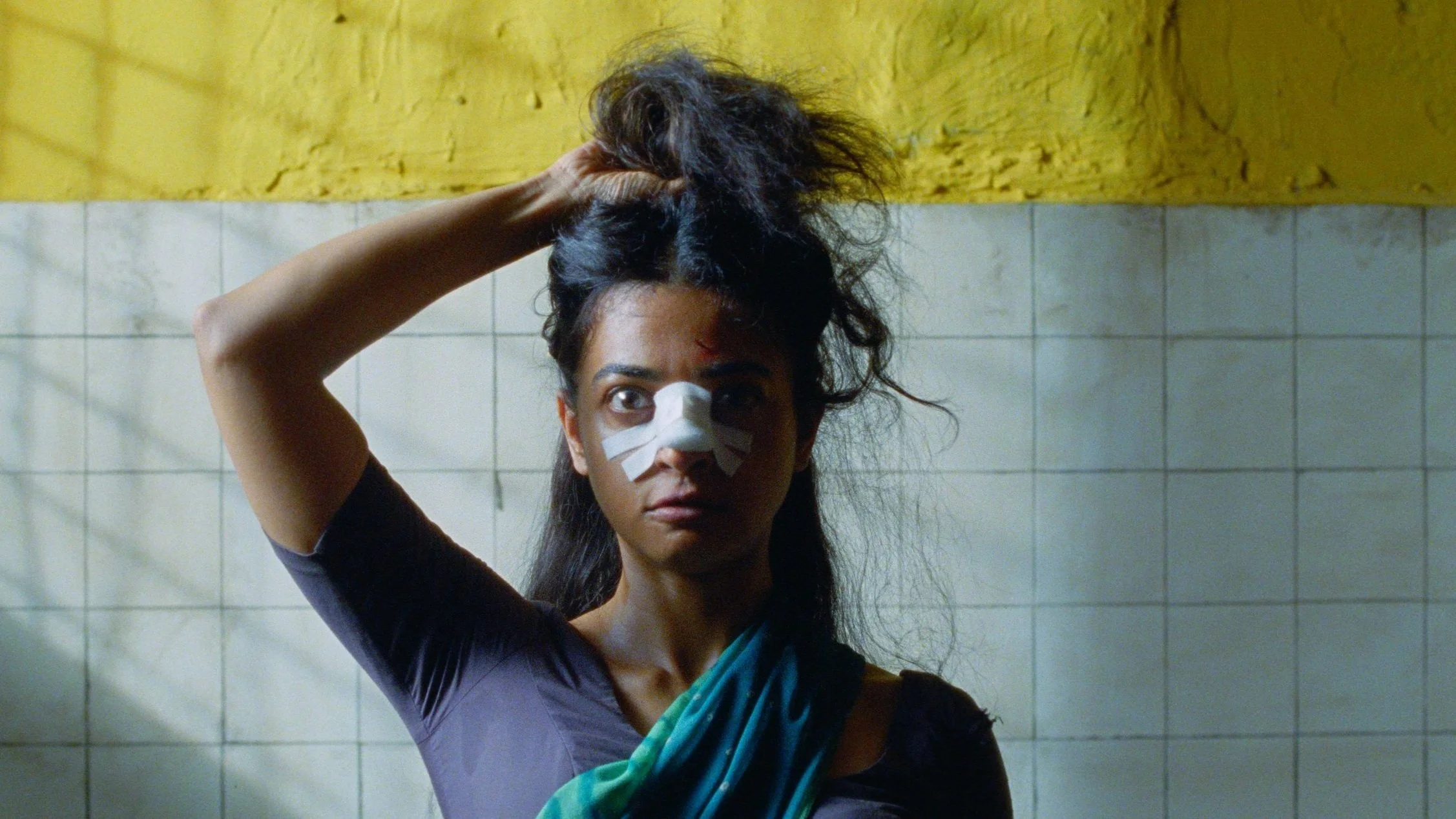Sister Midnight
Karan Kandhari’s vivid, surreal feature debut proves to be a striking but divisive black comedy.
Image courtesy of Altitude Film Distributors.
Apart from a student film which he made in 2005 Sister Midnight represents the first feature of Karan Kandhari. It's a work that has attracted attention and when it was screened at the London Film Festival in 2024 it was described as defying easy categorisation. That statement is very true but it can be considered either a recommendation or a warning and deciding how to take it in this instance quite possibly comes down to personal taste. In writing and directing Sister Midnight Kandhari has undoubtedly created an Indian film with a difference and one that feels distinctly modern (I should perhaps say that this work is a co-production also involving the UK and Sweden but its setting is Mumbai and the dialogue is in Hindi throughout).
However much responses to it may differ, there are a number of things that can be said about Sister Midnight with certainty. One is that there is great photography here with Sverre Sørdal ensuring that Kandhari’s film is full of vibrant colour. It's also a work which throughout focuses strongly on its central character: this is Uma a newly-wed from outside Mumbai who is the bride in an arranged marriage. Uma is played by Radhika Apte who stamps the film with her presence while receiving sound support from Ashok Pathak and Chhaya Kadam. Pathak has the role of the somewhat reluctant and unsatisfactory husband, Gopal, and Kadam, who was recently seen in All We Imagine as Light, appears as the couple’s neighbour. Furthermore, Kandhari’s style of direction proves to be very individual. He is a filmmaker who delights in playing down dialogue to let the images themselves – most especially the facial expressions of the players together with their body language – convey much of the story. His approach is also one that often features relatively short scenes and again and again he likes to end them by fading to black. Another idiosyncrasy lies in his decision to tell this decidedly Indian tale in a manner which often incorporate songs on the soundtrack, the distinctive element here being that many of the songs are American and/or recordings by rock bands. Those called on include Buddy Holly, Marty Robbins, The Stooges, The Band and Motörhead.
Long before the dialogue tells us more, Sister Midnight reveals what married life is like for Uma and Gopal. As a husband Gopal sees a wife as somebody who does the shopping and prepares his meals while he, shy and probably sexually inexperienced, is happiest going out to get drunk with male friends leaving Uma in a role virtually indistinguishable from that of a domestic servant. It's a way of life that could be portrayed on the screen as a realistic tale told with pronounced miserabilism. But Sister Midnight which has been described as a surrealist fable is the reverse of that. It feels as strongly feminist as the other approach could be but, colourful visuals aside, its key feature is to make Uma a rebellious and outspoken figure (part of what makes the film seem modern is the fact that unlike most Indian cinema this piece contains much strong language). This tone has contributed to the Sister Midnight being described as wild and punk-like in addition to being called a dark comedy.
In effect the film falls into three sections. The first is the segment which, however original in style, comes closest to being a clear critique of arranged marriages and which although written by a male is meaningfully feminist in outlook. It portrays Gopal in a manner that echoes how Ken is first presented in the film Barbie. However, after Uma asserts herself their relationship changes and when they start to regard each other as friends it leads to Gopal appearing in a new light. But that is just the middle portion of the film and what one should read into this is far from clear. There are already hints of Uma developing some strange condition that is no normal illness and reviews of the film indicating plot developments without wanting to reveal too much have stated that Uma becomes feral. This had suggested to me that Sister Midnight might turn into a horror film and in its last third it both does and doesn't which is about as much as I can say without giving away more than I should.
Two facts stand out, however. First, although no horror fan myself, I think that any lovers of that genre will find that Sister Midnight stops well short of providing the kind of satisfaction that they are looking for. But at the same time, if this is indeed a film about the need for women to rebel in a manner that comes from within, the direction that it eventually takes is bizarrely surreal rather than meaningful. The strange role given to animals in the film is part and parcel of this. The other point concerns the humour in the film. One brief scene takes it firmly into effective black comedy but elsewhere the stylisation involves a comic aspect that will mean much more to some viewers than to others. That leaves Sister Midnight as a Marmite film which has an effective lead actress and is made with assurance on the part of Karan Kandhari but is possessed of such an offbeat individuality that it is bound to divide opinion.
MANSEL STIMPSON
Cast: Radhika Apte, Ashok Pathak, Chhaya Kadam, Smita Tambe, Navya Sawant, Dev Raaz, Chaitanya Solankar, Suhass Ahuja, Masashi Fujimoto, Daemian Greaves, Akihide Monna.
Dir Karan Kandhari, Pro Alastair Clark, Anna Griffin and Alan McAlex, Screenplay Karan Kandhari, Ph Sverre Sørdal, Pro Des Shruti Gupte, Ed Napoleon Stratogiannakis, Music Paul Banks, Costumes Sagarikaa Pilla.
BFI/Wellington Films/Griffin Pictures/Film4/Film iVäst/Filmgate Films/Suitable Pictures-Altitude Film Distributors.
107 mins. UK/India/Sweden. 2024. UK Rel: 14 March 2025. Cert. 15.


